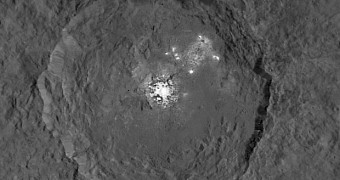New views of dwarf planet Ceres reveal the topography of one of the craters present on the surface of the orb. The images, delivered by the Dawn spacecraft, bring into focus intriguing spots that shine brighter than other features on Ceres and whose origin is still up for debate.
The spots were first detected many months ago, before Dawn caught up with the dwarf planet and placed itself in its orbit. At the time, however, the images provided by the probe were not exactly sharp, and so the bright areas appeared more like blotches.
The latest views of the orb, which NASA combined to produce an animated fly-around and a colorful topographic map of Ceres' Occator crater, are the closest yet and reveal the spots and their home landscape in exquisite detail. All the same, it's still unclear what the spots might be.
“The brightest spots on the dwarf planet Ceres gleam with mystery in new views delivered by NASA's Dawn spacecraft,” mission scientists write in the animation's description.
“Dawn has transformed what was so recently a few bright dots into a complex and beautiful, gleaming landscape,” adds Marc Rayman, Dawn's chief engineer and mission director.
Researchers expect to soon sort out the mystery
The images included in the video below were obtained by NASA's Dawn spacecraft from an altitude of about 915 miles (1,470 kilometers). They reveal the anatomy of Ceres' Occator crater at a resolution of 450 feet (140 meters) per pixel.
The crater is estimated to measure around 60 miles (90 kilometers) across and reach a depth of 2 miles (4 kilometers). In some places, the crater's rim is almost vertical, rising steeply for 1 mile (almost 2 kilometers), astronomers say.
It might be that these new views of Ceres' Occator crater are better defined than previous ones, which were obtained from higher orbits, but mission scientists haven't yet figured out what the bright spots shinning at the bottom could be.
True, they now have a better idea of their shape, but their origin is still a mystery. Then again, they are confident they'll eventually sort things out.
“Soon, the scientific analysis will reveal the geological and chemical nature of this mysterious and mesmerizing extraterrestrial scenery,” promises researcher Marc Rayman.
Dawn is now busy mapping Ceres in its entirety
For about three weeks now, NASA's Dawn spacecraft has been mapping Ceres' surface while orbiting it at a steady altitude of 915 miles (1,470 kilometers). It has so far completed two 11-day mapping cycles and will complete another six over the next couple of months.
Data and images beamed back to Earth will then be used by mission scientists over at NASA to construct three-dimensional maps and animated videos documenting the dwarf planet's topography.

 14 DAY TRIAL //
14 DAY TRIAL // 